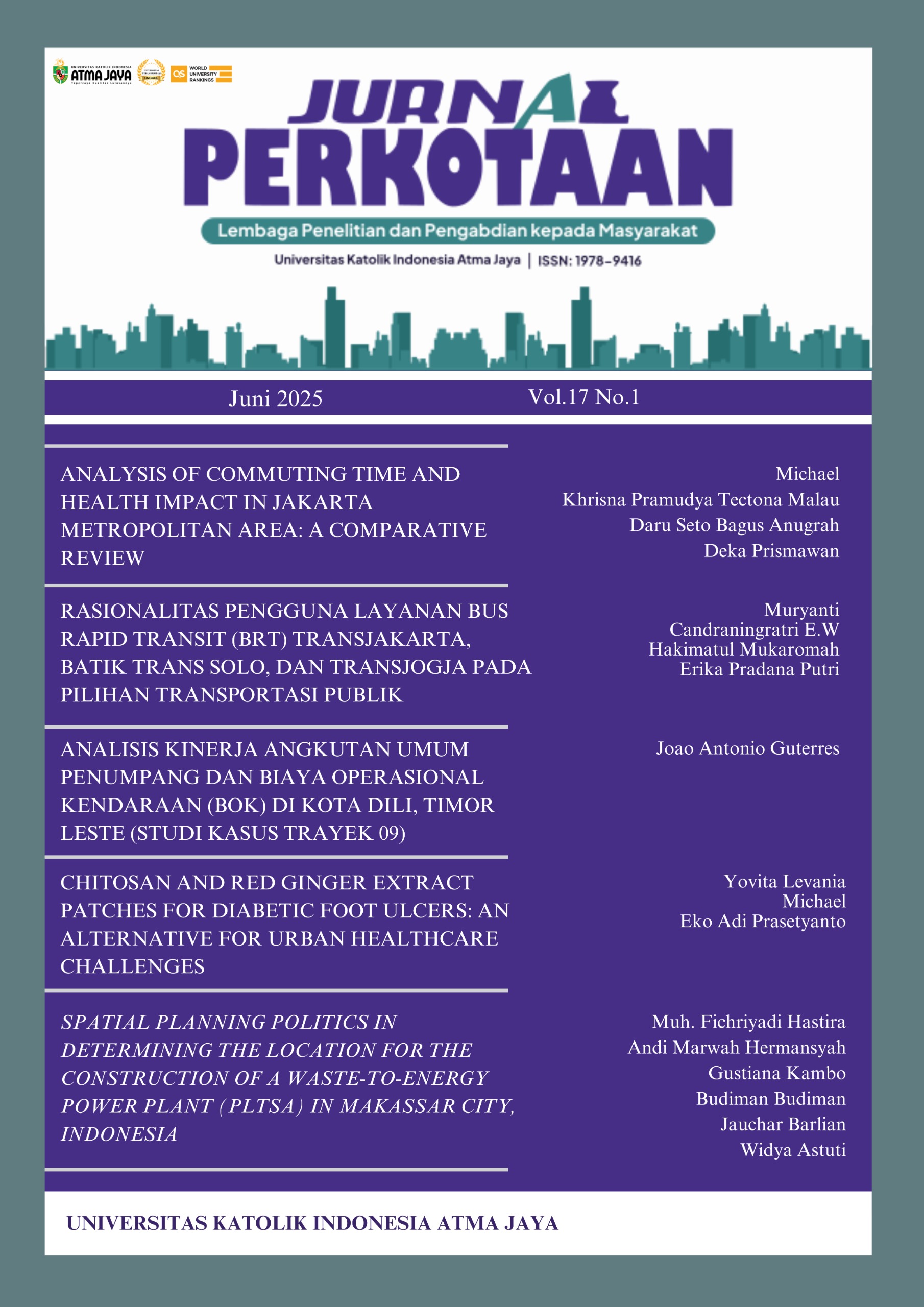Analysis of Commuting Time and Health Impact in Jakarta Metropolitan Area: A Comparative Review
DOI:
https://doi.org/10.25170/perkotaan.v17i1.6325Keywords:
Commuting time, Jakarta Metropolitan Area, Health impacts, Public transportation, Private transportationAbstract
Commuting in the Jakarta Metropolitan Area (Jabodetabek) presents significant challenges, including long travel times, congestion, and environmental concerns, which affect commuters' health and well-being. This study provides a comparative review of commuting patterns, transportation modes, and their associated health impacts. By analyzing secondary data, the research identifies key issues such as the prevalence of private vehicle use, overcrowded public transport, and limited infrastructure for sustainable travel. The findings reveal that prolonged commutes are linked to physical inactivity, musculoskeletal problems, respiratory conditions, and mental stress, exacerbated by inadequate transportation systems and environmental factors. Comparisons with other global cities underscore the importance of integrated transit networks, sustainable transport policies, and urban planning to mitigate these impacts. This review aims to inform policy decisions to enhance the quality of life for Jakarta’s commuters and foster a more sustainable urban future.
References
[1] A. Aritenang, “Examining Socio-Economic Inequality Among Commuters: The Case of the Jakarta Metropolitan Area,” UP, vol. 7, no. 3, pp. 172–184, Jul. 2022, doi: 10.17645/up.v7i3.5271.
[2] Y. Sofiyandi and A. A. Siregar, “Exploring the Changes of Commuting Patterns, Commuting Flows, and Travel-to-work Behaviour in the Jakarta Metropolitan Area from 2014 to 2019: A Comparative Analysis of Two Cross-sectional Commuting Surveys,” in Lembaga Penyelidikan Ekonomi dan Masyarakat - Fakultas Ekonomi dan Bisnis - Universitas Indonesia, Aug. 2020.
[3] A. Gaduh, T. Gračner, and A. D. Rothenberg, “Life in the slow lane: Unintended consequences of public transit in Jakarta,” Journal of Urban Economics, vol. 128, p. 103411, Mar. 2022, doi: 10.1016/j.jue.2021.103411.
[4] T. Tjahjono, A. Kusuma, and A. Septiawan, “The Greater Jakarta Area Commuters Travelling Pattern,” Transportation Research Procedia, vol. 47, pp. 585–592, 2020, doi: 10.1016/j.trpro.2020.03.135.
[5] T. P. B. Pradonoputro and O. Kozo, “Understanding Commuter’s Motivation of Transportation Choice: A Case Study of Greater Jakarta,” Jurnal Manajemen Transportasi & Logistik (JMTRANSLOG), 2021.
[6] D. A. Christian, A. Bachtiar, and C. Candi, “Analysis of Health-Based Transportation System for Health Transformation in DKI Jakarta,” JOSR, vol. 2, no. 11, pp. 4103–4112, Oct. 2023, doi: 10.55324/josr.v2i11.1568.
[7] G. Syuhada et al., “Impacts of Air Pollution on Health and Cost of Illness in Jakarta, Indonesia,” IJERPH, vol. 20, no. 4, p. 2916, Feb. 2023, doi: 10.3390/ijerph20042916.
[8] Statistics Korea, “Regional population and population density [Internet],” Statistics Korea, 2023. [Online]. Available: https://www.index.go.kr/unity/potal/main/EachDtlPageDetail.do?idx_cd=1041
[9] Badan Pusat Statistik Provinsi DKI Jakarta, “Jumlah Penduduk Menurut Kabupaten/Kota di Provinsi DKI Jakarta - Tabel Statistik.” Accessed: Nov. 22, 2024. [Online]. Available: https://jakarta.bps.go.id/id/statistics-table/2/MTI3MCMy/jumlah-penduduk-menurut-kabupaten-kota-di-provinsi-dki-jakarta-html
[10] Badan Pusat Statistik Provinsi Jawa Barat, “Jumlah Penduduk Menurut Kabupaten/Kota - Tabel Statistik.” Accessed: Nov. 22, 2024. [Online]. Available: https://jabar.bps.go.id/id/statistics-table/2/MTMzIzI=/jumlah-penduduk-menurut-kabupaten-kota.html
[11] Badan Pusat Statistik Provinsi Banten, “Jumlah Penduduk Menurut Kabupaten/Kota dan Jenis Kelamin di Provinsi Banten - Tabel Statistik - Badan Pusat Statistik Provinsi Banten.” Accessed: Nov. 22, 2024. [Online]. Available: https://banten.bps.go.id/id/statistics-table/2/NTIxIzI=/jumlah-penduduk-menurut-kabupaten-kota-dan-jenis-kelamin-di-provinsi-banten.html
[12] BPS-Statistics Indonesia Dki Jakarta, “Labor Force Participation Rate - Statistical Data.” Accessed: Apr. 25, 2025. [Online]. Available: https://jakarta.bps.go.id/en/statistics-table/2/NzcyIzI=/labor-force-participation-rate.html
[13] R. S. Hutajulu, F. T. Ayuningrum, P. I. Firdaus, R. Solih, and F. Hermawati, Statistik Komuter Jabodetabek Hasil Survei Komuter Jabodetabek 2023, vol. 3. Badan Pusat Statistik, 2024.
[14] T. Agustina, S. P. Eni, R. Ismanto, and U. Ulinata, “Connecting facilities of several modes of transportation with transit-oriented development approach,” IOP Conf. Ser.: Earth Environ. Sci., vol. 878, no. 1, p. 012036, Oct. 2021, doi: 10.1088/1755-1315/878/1/012036.
[15] H. L. H. Spits Warnars, Y. Lanita, A. Prasetyo, and R. Randriatoamanana, “Smart Integrated Payment System for Public Transportation in Jakarta,” Bulletin EEI, vol. 6, no. 3, pp. 241–249, Sep. 2017, doi: 10.11591/eei.v6i3.655.
[16] A. D. Nurlukman, Y. Fadli, and Nurhakim, “Satisfaction Impact of Transjakarta Integrated Transportation System Quality Services,” J Phys: Conf Ser, vol. 1477, 2020, doi: 10.1088/1742-6596/1477/7/072014.
[17] F. A. Mahendra, M. S. Widodo, and M. R. A. Pratama, “Reputation of the Quality Portrait Satisfaction of Jakarta’s Integrated Mass Rapid Transit (MRT) Implies Community Sustainability,” vol. 1, no. 2, pp. 148–159, Oct. 2024, doi: 10.55606/mri.v1i2.1059.
[18] W. B. Dermawan, E. F. Tandilino, and M. Isradi, “Passenger Satisfaction Analysis of Urban Transportation System Service Jak Lingko,” ADRI International Journal of Engineering and Natural Science, vol. 6, no. 1, 2021, doi: 10.29138/aijens.v6i01.27.
[19] A. Setyawati and H. Hasan, “Effect of service quality and facilities on commuter line train user satisfaction: a case of Indonesia,” Journal of Economics, Management, Entrepreneur, and Business, vol. 1, no. 2, pp. 187–200, 2021.
[20] A. F. Both, D. Westerdahl, S. Fruin, B. Haryanto, and J. D. Marshall, “Exposure to carbon monoxide, fine particle mass, and ultrafine particle number in Jakarta, Indonesia: Effect of commute mode,” Science of The Total Environment, vol. 443, pp. 965–972, Jan. 2013, doi: 10.1016/j.scitotenv.2012.10.082.
[21] J. I. Halonen et al., “Commuting time to work and behaviour-related health: a fixed-effect analysis,” Occup Environ Med, vol. 77, no. 2, pp. 77–83, Feb. 2020, doi: 10.1136/oemed-2019-106173.
[22] F. Sha, B. Li, Y. W. Law, and P. S. F. Yip, “Associations between commuting and well-being in the context of a compact city with a well-developed public transport system,” Journal of Transport & Health, vol. 13, pp. 103–114, Jun. 2019, doi: 10.1016/j.jth.2019.03.016.
[23] T. J. Christian, “Trade-Offs Between Commuting Time and Health-Related Activities,” J Urban Health, vol. 89, no. 5, pp. 746–757, Oct. 2012, doi: 10.1007/s11524-012-9678-6.
[24] C. M. Hoehner, C. E. Barlow, P. Allen, and M. Schootman, “Commuting Distance, Cardiorespiratory Fitness, and Metabolic Risk,” Am J Prev Med, vol. 42, no. 6, pp. 571–578, Jun. 2012, doi: 10.1016/j.amepre.2012.02.020.
[25] J. Jung, J. B. Park, K.-J. Lee, Y. Seo, and I. Jeong, “Association between commuting time and work-related low back pain with respect to sports and leisure activities in Korean workers,” Ind Health, vol. 62, no. 2, pp. 133–142, 2024, doi: 10.2486/indhealth.2023-0100.
[26] Y.-H. Chen, J. J. Lin, C. Yang, H.-M. Tang, G.-P. Jong, and T.-Y. Yang, “The effect of commuting time on burnout: the mediation effect of musculoskeletal pain,” BMC Health Serv Res, vol. 24, p. 468, Apr. 2024, doi: 10.1186/s12913-024-10908-1.
[27] M. Kimura et al., “Influence of commuting methods on low back pain and musculoskeletal function of the lower limbs in elementary school children: A cross-sectional study,” Journal of Orthopaedic Science, vol. 27, no. 5, pp. 1120–1125, Sep. 2022, doi: 10.1016/j.jos.2021.05.013.
[28] N. Jacob, L. Munford, N. Rice, and J. Roberts, “Does commuting mode choice impact health?,” Health Econ, vol. 30, no. 2, pp. 207–230, Feb. 2021, doi: 10.1002/hec.4184.
[29] R. Noichan and B. Dewancker, “Analysis of Accessibility in an Urban Mass Transit Node: A Case Study in a Bangkok Transit Station,” Sustainability, vol. 10, no. 12, Art. no. 12, Dec. 2018, doi: 10.3390/su10124819.
[30] T. Teunissen, “An ex-post evaluation framework for BRT and MRT in Mexico : A study on the impacts of Bus Rapid Transit and Mass Rapid Transit in Mexico City,” Mar. 2014, [Online]. Available: http://essay.utwente.nl/65036/
[31] A. H. Xiao, “The congested city and situated social inequality: Making sense of urban (im)mobilities in Lagos, Nigeria,” Geoforum, vol. 136, pp. 312–320, Nov. 2022, doi: 10.1016/j.geoforum.2021.04.012.
[32] C. Mulley, J. Nelson, and S. Ison, Eds., The Routledge Handbook of Public Transport. London: Routledge, 2021. doi: 10.4324/9780367816698.










